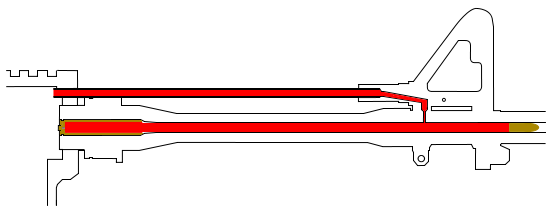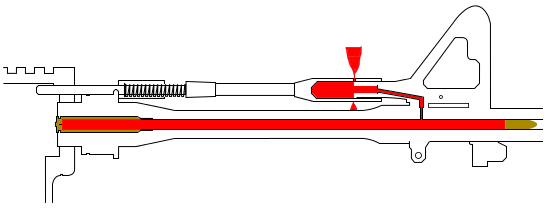
Photo Courtesy of Evers
There seems to be no shortage of age-old debates in the firearms community. From the “9mm vs 45 ACP” question and beyond, everyone is going to try to tell you one system is better than another. However, the truth is usually somewhere in the middle. We’re going to look at one of those classic debates in this post as we break down the differences and similarities between direct impingement and gas piston recoil systems.
What Does Direct Impingement Mean?
If you’re a fan of the AR platform, chances are you’re familiar with how direct impingement systems work. In simplest terms, direct impingement firearms use expanding gas to cycle the gun. The expanding gas passes from the barrel into a gas tube before pushing directly on the bolt carrier or slide assembly.
While the AR-15 isn’t the first or only gun to use a direct impingement system, it is the most modern and successful firearm to do so. DI systems have several benefits. For one, they have fewer metal pieces. That equates to less overall weight. And since there’s no reciprocating mass pushing back against the shooter like there is in a gas piston gun, DI firearms have less perceived recoil. That makes follow-up shots much easier.
DI guns also have one huge advantage over their gas piston brethren. Since there’s no direct physical contact between the gas tube and the gun’s action, barrels can be “free-floated.” That makes them considerably more accurate than their gas piston counterparts since there’s no reciprocating mass working to move the barrel around. This is the source of the “ARs are more accurate than AKs” piece of gun lore.
That doesn’t mean they’re perfect, though. Because DI guns use gas itself to cycle the action, they generally run hotter and dirtier. That’s to be expected, considering you’re blowing gas and carbon dust back into your chamber and barrel.
How do Gas Piston Firearms Work?
In theory, gas piston guns work similarly to DI ones. Both of these systems use gas to cycle a firearm’s action, they just go about it differently. While direct impingement guns push on the action directly, firearms with gas pistons don’t. Instead, they force gas against a metal piston, which in turn pushes back against the bolt to cycle the gun.
Gas piston guns run significantly more cleanly than DI guns do. That’s because they keep gas and carbon fouling from entering the “shooty parts” of the gun. Generally speaking, gas piston weapons fall into one of two categories: long-stroke and short-stroke. We’ll break down the differences between these systems below.
Long-Stroke Gas Pistons
Long-stroke gas piston from an AKM. Gas pushes on the piston (from the right) to cycle the bolt (the lower part on the left). (Photo Courtesy of Zeos386sx)
If you’re an AK fan, you know all about long-stroke gas pistons. These types of systems are incredibly robust. With a long-stroke gas piston, gas pushes back on one big piston connected to the gun’s bolt carrier group. This cycles the action.
Long-stroke gas pistons do have some disadvantages. For one, the gas piston is pretty massive. As a result, the perceived recoil on these guns is pretty high. That makes follow-up shots fairly difficult. Additionally, long-stroke gas pistons have a significant reciprocating mass that acts on the barrel. This can move the barrel around between shots, making it less accurate.
Aside from AKs, the IWI Tavor, M1 Garand, and M14 all use long-stroke gas pistons.
Short-Stroke Gas Pistons

Diagram of a short-stroke system. (Photo Courtesy of Evers)
The short-stroke gas piston is sort of a “middle ground” between DI and long-stroke systems. In a short-stroke system, gas pushes on a piston. That piston, in turn, pushes on another mechanism (like a connecting rod), which directly cycles the action.
Short-stroke systems have some advantages over both DI and long-stroke systems. Like a long-stroke system, they run much cleaner than DI does. And since the piston doesn’t directly cycle the bolt, short-stroke systems also exhibit less recoil and higher accuracy than a long-stroke system. However, since the piston has to hammer against a connecting rod or some other mechanism to cycle the bolt, they’re less robust than long-stroke gas systems and have a shorter operational life.
The M1 Carbine, SKS, VZ-58, and some AR-15 variants (like the SIG MCX) operate using short-stroke gas pistons.
What are some other system comparisons you would like to read about? Let us know at either marketing@sdi.edu or shoot us a message on one of our social media accounts.




